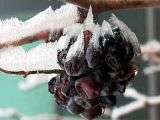


Ice wine, Eiswein en Vendanges Tardives
Nu de koude winterweken hun entree hebben gemaakt en wij binnen genieten van culinaire menu's en heerlijke wijnen, zijn we ons nauwelijks bewust, dat in diverse wijnbouwgebieden op de wereld men juist op deze vorstperiode wacht. Het is het moment waarop de druiven worden geplukt voor het maken van overheerlijke dessertwijn. We noemen Ice wine, Eiswein en Vendanges Tardives, maar hoe maakt men van deze bevroren druiven zo'n heerlijke wijn.
Wat gaat er schuil achter al deze begrippen?
En waar en hoe worden deze technieken toegepast?
Een snelle blik in de Wikipedia vertelt ons klip en klaar het volgende:
"Ice wine (or icewine, as one word, or in German, Eiswein) is a type of dessert wineproduced from grapesthat have been frozen while still on the vine. The sugarsand other dissolved solids do not freeze, but the water does, allowing a more concentrated grape mustto be pressed from the frozen grapes, resulting in a smaller amount of more concentrated, very sweet wine. With ice wines, the freezing happens before the fermentation, not afterwards. Unlike the grapes from which other dessert wines, such as Sauternes, Tokaji, or Trockenbeerenauslese, are made, ice wine grapes should not be affected by Botrytis cinereaor noble rot, at least not to any great degree. Only healthy grapes keep in good shape until the opportunity arises for an ice wine harvest, which in extreme cases can occur after the New Year, on a northern hemisphere calendar. This gives ice wine its characteristic refreshing sweetness balanced by high acidity. When the grapes are free of Botrytis, they are said to come in "clean".
Due to the labour-intense and risky production process resulting in relatively small amounts of wine, ice wines are generally quite expensive."
"The most famous (and expensive) ice wines are German Eiswein[10] and Canadian Icewine (where the name is written as one word), but ice wine is also made in Australia, Austria, Croatia, Czech Republic, France, Hungary, Israel, Italy, Luxembourg, New Zealand, Slovakia, Slovenia, Sweden and United States, at least in smaller quantity. Eiswein is part of the Prädikatswein quality category in the German wine classification, and Icewine in Canada must follow VQA protocol to be labelled as such. The French language term Vin de glace is part of the wine classification in Luxembourg, but not in France, but is sometimes found on the rare bottles of ice wine produced in Alsace.
In contrast to most other wine-producing regions, Canada, particularly the Niagara Peninsula, consistently undergoes freezing in winter and has become the world's largest ice wine producer.[11][12] Icewine production in Canada is regulated by the Vintners Quality Alliance in the provinces of British Columbia and Ontario. If the sugar level in the grapes measures less than 35° Brix, then they may not be used for icewine, a minimum considerably higher than that of German Eiswein.[11] These grapes are often downgraded to a lower designation, such as Special Select Late Harvest or Select Late Harvest. Canadian rules were further tightened in British Columbia in 2000 after a producer dealt with the mild winter of 1999 by moving grapes up to the mountains to seek freezing temperatures.[13]
Though Pelee Island Winery and Hildebrand were Canada's first commercial icewine producers, starting production in 1983, Inniskillin Wines is considered the most widely known Canadian icewine producer as the first Canadian winery to win a major international award, the Grand Prix d’Honneur at 1991 Vinexpo in France, with their 1989 Vidal Icewine (which was technically an illegal import into the EU[11]), placing Canadian icewines on the world stage.[14] Pillitteri Estate Winery has emerged in the 2000s as the world’s largest estate icewine producer.[14][15] In November 2006 the Canadian producer Royal DeMaria released five cases of Chardonnay icewine with a half-bottle price set at C$ 30,000, making it the world's most expensively priced wine.[16]""Late harvest wines:
There are two late harvest classifications, Vendange Tardive (VT) and Sélection de Grains Nobles (SGN). Vendange Tardive means "late harvest" (which in German would be Spätlese), but in terms of must weight requirements, VT is similar to Auslese in Germany. Sélection de Grains Nobles means "selection of noble berries", i.e. grapes affected by noble rot, and is similar to a German Beerenauslese. For both VT and SGN, Alsace wines tend to be higher in alcohol and therefore slightly lower in sugar than the corresponding German wines. Therefore, Riesling VT and Muscat VT tend to be semi-sweet rather than sweet, while Gewürztraminer and Pinot Gris tend to be rather sweet already at VT level. But as is the case with sweetness in other Alsace wines, this depends to a large extent on the house style of the producer.
The required level of ripeness of the grapes, which was increased in 2001, are as follows, expressed as sugar content of the must and potential alcohol."De beroemde
Vendanges Tardiveen de
Sélection de Grains Noblesworden in de Elzas o.a. gemaakt door Vignobles Francois Muhlberger.
U kunt eenvoudig online bestellen bij http://www.bacchuswijnkoperij.nl/
Benieuwd hoe deze bijzondere wijze van produceren in Canada en Amerika worden toegepast?
Een kort filmpje en u leert de geheimen van deze wijn kennen......
Heb je de smaak al te pakken? Echt benieuwd en lijkt het je een avontuur om deze wijn in je bezit te krijgen?
Kijk op onze website: http://www.bacchuswijnkoperij.nl/ en ontdek hoe makkelijk het zelf importeren van wijn is.


